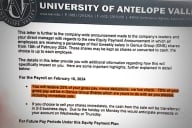You have /5 articles left.
Sign up for a free account or log in.
The for-profit college sector is under intense regulatory scrutiny and several major players are shutting down, so some providers are embracing reforms to differentiate themselves.
DeVry Education Group is the latest to do so: it announced today that it will voluntarily limit the amount of federal revenue, including from veterans and military tuition assistance, it receives by lowering the so-called federal 90-10 rule at each of its institutions.
That rule requires for-profit institutions to receive at least 10 percent of their revenue from nonfederal sources. DeVry plans to change the ratio to 85-15, which is what the federal ratio was from 1992 to 1998.
"This is a significant pledge that DeVry Group is voluntarily making for the long term, and it underscores our commitment to finding solutions to the issues facing higher education today," said Lisa Wardell, president and chief executive officer of DeVry Education Group, in an interview with Inside Higher Ed. "This is part of a broader effort to improve our policies and demonstrate the quality and value of our programs."
The controversial 90-10 rule has been criticized by congressional Democrats and the Democratic presidential nominee, Hillary Clinton, because it currently doesn't count veterans' educational benefits toward the 90 percent limit. That loophole, they argue, increases the likelihood that for-profits will aggressively recruit military veterans.
Wardell said that the for-profit sector is at a turning point, and DeVry wanted to be the first to make this change. The company is expecting all of its institutions to reach the new threshold -- and stay beneath it -- by July 2017. After that, the company is planning to publish the ratio for all its campuses annually, she said.
"There is growing and bipartisan support for returning to the 85 percent limit on federal funds and for closing the veterans and military funds loophole," Jennifer Wang, D.C. office director for the Institute for College Access and Success, said in an email. "DeVry recently did the same thing [by] voluntarily announcing it would stop forcing students into arbitration, in advance of anticipated final regulations banning schools from requiring arbitration."
DeVry isn't planning to change its access or financial aid process, Wardell said, adding that one way it is planning to meet the new threshold is through DeVry Works, its initiative that connects students to employers. Those employers would hire students and provide tuition assistance.
A corporate filing from the company reveals that all DeVry institutions are below the federal 90-10 threshold as of 2015, but those ratios don't include veterans or military benefits. For instance, Ross University School of Veterinary Medicine receives 84 percent of its revenue from federal sources. Chamberlain College of Nursing receives 65 percent, while DeVry University's undergraduate and graduate programs were at 68 percent and 67 percent of revenue from federal sources, respectively.
DeVry's other holdings -- Becker Professional Education and DeVry Brasil -- do not receive any federal student aid.
"In all due respect to DeVry's proposal, how does this affect the school and your programs, because most of their four-year liberal arts and medical programs are nowhere close to 90-10 threshold, so doing something that doesn't cost you isn't really courageous," said Steve Gunderson, president and chief executive officer of Career Education Colleges and Universities, which represents many institutions in the for-profit sector. (DeVry is not a CECU member.) "When you look at all postsecondary education, look at the two-year career programs because they tend to serve a demographic that is much more low income. Of all of the DeVry programs, the one that comes close is Carrington College, but all their other programs wouldn't be impacted."
Carrington's Phoenix location, for instance, receives 80 percent of its revenue from federal sources.
Gunderson said the focus shouldn't be on the ratio of federal dollars going to for-profits, but instead on how for-profits can serve the increasing number of low-income students and veterans who depend on government resources.
"When you look at a school in the inner city serving low-income, minority students and they're at that threshold of 85-15 … you have to ask, 'Who did they deny enrollment to?'" Gunderson said. "Is it the low-income single mother or the veteran, because if they accept them they'll go over that threshold?"
Instead, Gunderson said he would prefer to see more "skin in the game" solutions that look at the total public resources invested across all sectors and the student outcomes that every institution produces.
But similar to the decision by DeVry and Apollo Education Group, which owns the University of Phoenix, to end arbitration clauses, at least confronting issues like the 90-10 rule implies that other changes may be coming down the line.
"This strikes me as one of the more meaningful attempts at self-regulation that I've heard from a major player in this sector," said Ben Miller, senior director for postsecondary education at the Center for American Progress. "It's a sign that there's a recognition that the existing 90-10 rule doesn't work and needs to be updated, and in terms of improving the view of DeVry -- it doesn't hurt."
DeVry is still facing a lawsuit from the Federal Trade Commission for allegedly making deceptive claims about job placement rates and graduates' wages.
Wardell said the company is working with the FTC and the U.S. Department of Education to resolve the issue, but that the decision to alter the 90-10 threshold was unrelated to those dealings. Rather, she said, the company is looking to confront the issues that plague the for-profit sector.
"This will show, for us, a shift in focus to a resolution of issues," she said. "We don't disagree students come first and changes have to be made."
Institutions that exceed the 90-10 rule for two consecutive years lose the ability to participate in federal financial aid programs for at least two years. DeVry didn't explain what would happen if campuses don't reach or maintain the 85 percent threshold, but Wardell was assertive that the institutions will achieve the new threshold.
"DeVry is in the business of democratizing access to education, helping students achieve career goals and being a part of the solution to the workforce skills gap," Wardell said, adding that lowering the ratio is just one of a number of institutional reforms DeVry is developing.








